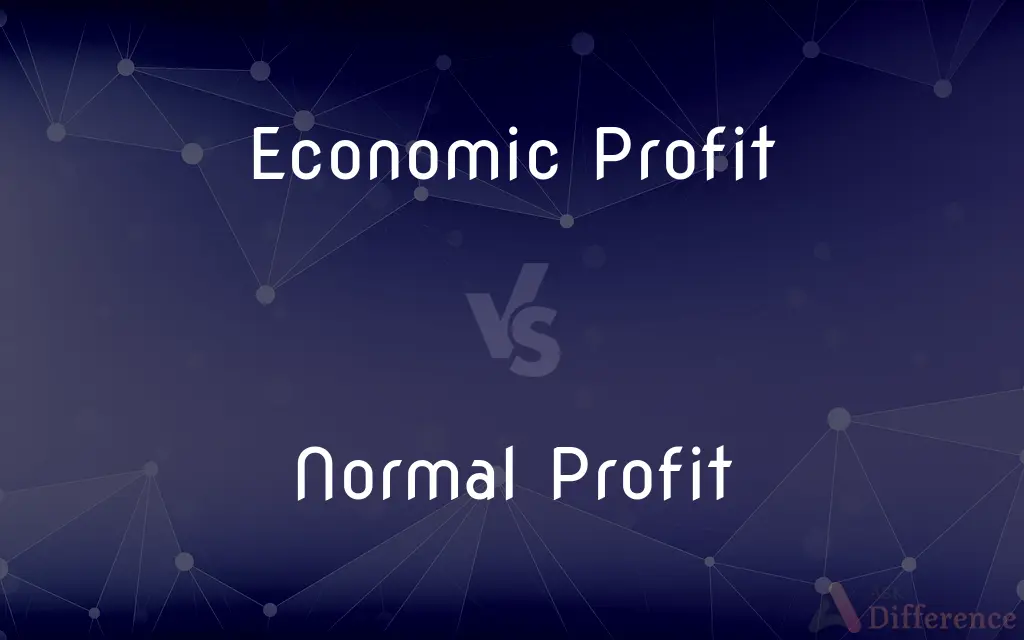Economic Profit vs. Normal Profit — What's the Difference?
By Fiza Rafique & Maham Liaqat — Published on March 3, 2024
Economic profit considers both explicit and implicit costs, including opportunity costs, indicating a firm's total profitability. Normal profit, a component of explicit costs, is the minimum earnings needed to keep a firm in its current industry.

Difference Between Economic Profit and Normal Profit
Table of Contents
ADVERTISEMENT
Key Differences
Economic profit and normal profit are key concepts in understanding a firm's financial health and decision-making process, but they serve different analytical purposes. Economic profit is a more comprehensive measure, accounting for all costs a firm incurs, including both explicit costs (direct monetary payments for resources) and implicit costs (the opportunity costs of using resources in their current use instead of the next best alternative). It's the surplus remaining after deducting both these cost types from total revenues and is a critical indicator of a firm's performance beyond merely covering its operational expenses.
Normal profit, on the other hand, is essentially the opportunity cost of a business owner's time and financial resources, embedded within the firm's explicit costs. It's the level of profit necessary for a firm to remain viable in its current industry, essentially representing the return that could have been earned had the resources been employed in the next best alternative venture. In economic theory, normal profit is when a firm's economic profit is zero, meaning the firm is covering all its costs, including the opportunity cost of capital and labor, but is not making any additional profit over this level.
Economic profit offers insight into a firm's ability to generate value beyond covering its costs, including the cost of forgoing other opportunities, whereas normal profit is a baseline measure, indicating that a firm is performing sufficiently to justify its continued operation in its current industry. A positive economic profit suggests a firm is not only viable but also thriving, as it's earning more than the total costs of its resources. Conversely, if a firm is only achieving normal profit, it's doing just enough to stay in business without generating extra value.
Understanding the distinction between economic and normal profit is crucial for business owners, investors, and economists, as it sheds light on a firm's operational efficiency, competitive advantage, and potential for long-term success. It also informs decisions related to resource allocation, investment, and strategic planning, with the aim of maximizing value creation and ensuring sustainable profitability.
Comparison Chart
Definition
Total revenues minus explicit and implicit costs.
The profit level that allows a firm to remain in its current industry, considered an explicit cost.
ADVERTISEMENT
Components
Includes opportunity costs (implicit costs) in addition to direct costs (explicit costs).
Embedded within explicit costs, representing the opportunity cost of resources.
Indicator of
A firm's profitability beyond covering all costs, including the foregone income from the next best alternative.
The minimum earnings needed for a firm to justify its existence in the current industry.
Role in Decision-Making
Guides strategic decisions by indicating potential for value creation beyond maintaining current operations.
Serves as a benchmark for assessing whether a firm is covering its opportunity costs and justifying its current operations.
Implication of Positive Value
The firm is generating surplus value over and above all costs, indicating strong performance and competitive advantage.
Normal profit is achieved when economic profit is zero; a firm earning normal profit is meeting its opportunity cost but not exceeding it.
Compare with Definitions
Economic Profit
Surplus revenue after accounting for both explicit and implicit costs.
Despite high operating expenses, the firm's innovative product line generated significant economic profit.
Normal Profit
A baseline for business viability.
Achieving normal profit is crucial for the café to sustain its presence in the competitive market.
Economic Profit
Reflects total opportunity costs.
Her economic profit calculation revealed the true cost of not investing in a more lucrative market.
Normal Profit
Essential for break-even analysis.
The break-even point was adjusted to include normal profit, ensuring the business plan accounted for opportunity costs.
Economic Profit
Varies with market conditions and competition.
Intense competition eroded the firm's economic profit as alternative opportunities became more attractive.
Normal Profit
Reflects the opportunity cost of business resources.
Her normal profit calculation considered the returns she forewent by not investing in the stock market.
Economic Profit
Indicator of above-normal performance.
The company's economic profit signals its superior market position and operational efficiency.
Normal Profit
The earnings level where a firm covers all its costs, including opportunity costs.
The startup finally reached normal profit, justifying its ongoing operations.
Economic Profit
Guides long-term strategic planning.
Economic profit analysis informed their decision to expand into new markets.
Normal Profit
Implicit in accounting profit calculations.
Although the accounting profit was high, normal profit adjustments showed a tighter margin.
Common Curiosities
Can a business have a high accounting profit but low or negative economic profit?
Yes, a business can show a high accounting profit while having low or negative economic profit if its implicit costs, especially opportunity costs, are high.
How can a firm increase its economic profit?
A firm can increase its economic profit by enhancing operational efficiency, creating unique value propositions, entering less competitive markets, or investing in high-return projects.
What happens if a firm only earns normal profit in the long term?
If a firm only earns normal profit in the long term, it may remain operational but lacks a competitive edge or significant investment appeal, potentially risking its market position if better opportunities arise.
Is normal profit considered a cost in economic analysis?
Yes, normal profit is considered a cost in economic analysis because it represents the opportunity cost of the resources employed in the business.
What role does innovation play in achieving economic profit?
Innovation can significantly contribute to economic profit by differentiating a firm's offerings, reducing costs, or creating new demand, thereby enhancing value creation beyond the norm.
Why might a firm continue to operate if it only earns normal profit?
A firm might continue to operate at normal profit if it meets the owners' or shareholders' required returns, justifying the use of resources in the current venture instead of alternatives.
How do market conditions affect economic and normal profits?
Market conditions, such as competition intensity and demand fluctuations, can impact both economic and normal profits by affecting revenues, costs, and the attractiveness of alternative opportunities.
Why is economic profit important for a business?
Economic profit indicates a business's efficiency in utilizing its resources and its ability to create value beyond just covering costs, guiding strategic decisions for growth and investment.
Can economic profit be sustained in a perfectly competitive market?
In a perfectly competitive market, economic profit tends to be driven to zero over time due to free entry and exit, leaving firms with just normal profit as they cover their opportunity costs.
How do changes in implicit costs affect economic profit?
Changes in implicit costs, such as increased opportunity costs due to better investment alternatives, can reduce economic profit by raising the total cost threshold for value creation.
Share Your Discovery

Previous Comparison
White Cornmeal vs. Yellow Cornmeal
Next Comparison
Heat vs. Thermal EnergyAuthor Spotlight
Written by
Fiza RafiqueFiza Rafique is a skilled content writer at AskDifference.com, where she meticulously refines and enhances written pieces. Drawing from her vast editorial expertise, Fiza ensures clarity, accuracy, and precision in every article. Passionate about language, she continually seeks to elevate the quality of content for readers worldwide.
Co-written by
Maham Liaqat















































